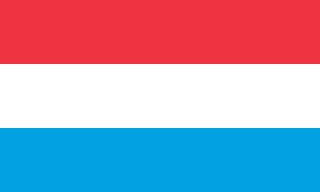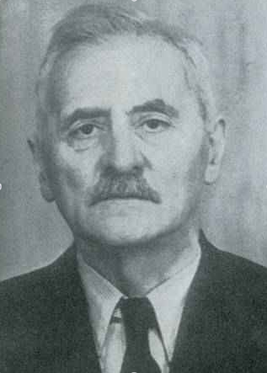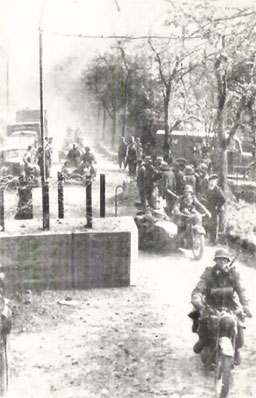Related Research Articles

Luxembourg, officially the Grand Duchy of Luxembourg, is a small landlocked country in Western Europe. It is bordered by Belgium to the west and north, Germany to the east, and France to the south. Its capital and most populous city, Luxembourg City, is one of the four institutional seats of the European Union and the seat of several EU institutions, notably the Court of Justice of the European Union, the highest judicial authority. Luxembourg's culture, people, and languages are greatly influenced by its much larger neighbors France and Germany; for example, Luxembourgish, a Germanic language, is the only national language of the Luxembourgish people and of the Grand Duchy of Luxembourg, French is the only language for legislation, and all three – Luxembourgish, German and French – are used for administrative matters in the country.

The Luxembourg Armed Forces are the national military force of Luxembourg. The army has been a fully volunteer military since 1967. As of December 2018, it has 939 personnel.
The German occupation of Luxembourg in World War II began in May 1940 after the Grand Duchy of Luxembourg was invaded by Nazi Germany. Although Luxembourg was officially neutral, it was situated at a strategic point at the end of the French Maginot Line. On 10 May 1940, the German Wehrmacht invaded Luxembourg, Belgium and the Netherlands. Luxembourg was initially placed under a military administration, but later became a civilly administrated territory and finally was annexed directly into Germany. The Germans believed Luxembourg to be a Germanic state, and attempted to suppress what they perceived as alien French language and cultural influences. Although some Luxembourgers joined the resistance or collaborated with the Germans, both constituted a minority of the population. As German nationals, from 1942, many Luxembourgers were conscripted into the German military. Nearly 3,500 Luxembourgish Jews were murdered during the Holocaust. The liberation of the country by the Allies began in September 1944, but due to the Ardennes Offensive it was not completed until early 1945.

Damian Kratzenberg was a highschool teacher who became head of the Volksdeutsche Bewegung, a pro-Nazi political group, in Luxembourg during World War II. He was executed after the war for collaboration with the Nazis.

The Communist Party of Luxembourg is a communist party in Luxembourg. Ali Ruckert is the current chairman of the party.

Victor Nicolas Bodson was a socialist Luxembourgish politician and lawyer who held the posts of Minister of Justice, Public Works, and Transport for long periods of time in the 1940s and 1950s, including in exile during World War II, when Luxembourg was occupied by Nazi Germany.
Émile Krieps was a Luxembourgish resistance leader, soldier, and politician. A member of the Democratic Party, Krieps served in cabinets under Pierre Werner and Gaston Thorn.
Aloyse Raths was a high member of the Luxembourgish Resistance during World War II.

The Luxembourgish Patriot League was a Luxembourgish Resistance movement during World War II. When Luxembourg was invaded and annexed by Nazi Germany in 1940, a national consciousness started to come about. The LPL was founded on 4 September 1940 at the Lycée of Echternach in Echternach by Raymond Petit.

The history of rail transport in Luxembourg began in 1846 and continues to the present day.

The Luxembourgish government in exile, also known as the Luxembourgish government in London, was the government in exile of Luxembourg during the Second World War. The government was based in London between 1940 and 1944, while Luxembourg was occupied by Nazi Germany. It was led by Pierre Dupong, and also included three other Ministers. The head of state, Grand Duchess Charlotte, also escaped from Luxembourg after the occupation. The government was bipartite, including two members from both the Party of the Right (PD) and the Socialist Workers' Party (LSAP).

The German invasion of Luxembourg was part of Case Yellow, the German invasion of the Low Countries—Belgium, Luxembourg and the Netherlands—and France during World War II. The battle began on 10 May 1940 and lasted just one day. Facing only light resistance, German troops quickly occupied Luxembourg. The Luxembourgish government, and Grand Duchess Charlotte, managed to escape the country and a government-in-exile was created in London.

The involvement of the Grand Duchy of Luxembourg in World War II began with its invasion by German forces on 10 May 1940 and lasted beyond its liberation by Allied forces in late 1944 and early 1945.
When Luxembourg was invaded and annexed by Nazi Germany in 1940, a national consciousness started to emerge. From 1941 onwards, the first resistance groups formed in secret, operating underground and in defiance of the German occupation. Their covert activities included aiding political refugees and those evading conscription into the German forces, as well as disseminating patriotic leaflets to bolster the Luxembourgish population's spirits.
The Consultative Assembly of Luxembourg was established in 1945 towards the end of World War II, when it became clear that the Chamber of Deputies could not fulfill its constitutional role. The point of the Consultative Assembly was to exercise those rights accorded to the Chamber by the constitution and laws, with the exception of legislative powers.

The Holocaust in Luxembourg refers to the systematic persecution, expulsion and murder of Jews in Luxembourg after its occupation and later annexation by Nazi Germany. It is generally believed that the Jewish population of Luxembourg had numbered around 3,500 before the war although many fled into France at the time of the German invasion of 10 May 1940 or in the early months of the occupation. Around 1,000 to 2,500 were murdered during the Holocaust after being deported to ghettos and extermination camps in Eastern Europe, under the Civil Administration of Gustav Simon.
Tony Bourg was a Luxembourgish professor, author, linguist, and literary scholar and critic.
Maurice Stein was a Luxembourgish Captain who headed the Gendarme and the Volunteer Corps. He was married to Georgette Schulze.
Carmen Ennesch was a Luxembourgish-French journalist, writer, and historian. She is known as the first female Luxembourgish journalist.
Henri Koch-Kent was a Luxembourgish publicist author, historian, active in the Luxembourgish Resistance during World War II.
References
- 1 2 3 4 ""Luxembourg". "Volume 5 Western and Northern Europe 1940–June 1942"". www.degruyter.com. doi:10.1515/9783110687699-012 . Retrieved November 5, 2022.
- 1 2 3 4 5 6 "Les Luxembourgeois sous-officiers et hommes qui ont servi au corps des Gendarmes et Volontaires" (PDF). 2022-10-06. Archived from the original (PDF) on 2022-10-06. Retrieved 2022-12-17.
- 1 2 3 4 5 "Alois Jacoby in the Germany, Concentration Camp Records, 1937-1945" . www.ancestry.com. Retrieved 2022-12-17.
- 1 2 Bulletin (in French). Imprimerie P. Worré-Mertens. 1965.
- ↑ Naturfreunde, Gesellschaft Luxemburger (1990). Bulletin de la Société des naturalistes luxembourgeois (in French). La Société.
- ↑ "Nvision crée le site «ons jongen a meedercher» pour les Enrôlés de Force". paperjam.lu (in French). Retrieved 2022-12-17.
- 1 2 3 4 5 6 Martens, Stefan; Prauser, Steffen (2014-09-16). La Guerre de 1940: se battre, subir, se souvenir (in French). Presses Universitaires du Septentrion. ISBN 978-2-7574-0771-4.
- 1 2 Youngstown Vindicator. Youngstown Vindicator.
- ↑ "Décès du Colonel E. Speller, Aide de Camp de S. A. R. Madame la Grande-Duchesse de Luxembourg" (PDF). Grand Duché de Luxembourg Ministére D'État Bulletin D'Information (in French). Vol. 8, no. 12. Luxembourg: Service information et presse. 29 February 1952. p. 30. Archived from the original (PDF) on 22 August 2016. Retrieved 24 May 2018.
- ↑ Ross, Harold Wallace; Shawn, William; Brown, Tina; Remnick, David; White, Katharine Sergeant Angell; Irvin, Rea; Angell, Roger (1951-05-12). The New Yorker. F-R Publishing Corporation.
- ↑ Chroniques étrangères: États-Unis (in French). Documentation française. 1949.
- 1 2 Warsaw Daily Times. Warsaw Daily Times.
- 1 2 Toledo Blade. Toledo Blade.
- 1 2 La Opinion. La Opinion.
- 1 2 Beaver Valley Times. Beaver Valley Times.
- 1 2 3 4 5 6 Thomas, Nigel (2014-02-20). Hitler's Blitzkrieg Enemies 1940: Denmark, Norway, Netherlands & Belgium. Bloomsbury Publishing. ISBN 978-1-78200-597-1.
- ↑ Lustiger, Arno (2011-09-30). Rettungswiderstand (in German). Wallstein Verlag. doi:10.5771/9783835321502. ISBN 978-3-8353-0990-6.
- 1 2 3 4 Redaktion. "Damals: Die Armee verlässt Luxemburg". www.tageblatt.lu (in German). Retrieved 2022-11-05.
- ↑ Melchers, Emile T. (1979). Kriegsschauplatz Luxemburg: August 1914, Mai 1940 (in German). Sankt-Paulus-Druckerei.
- 1 2 3 4 5 "Luxembourg Army History". 2006-08-22. Archived from the original on 2006-08-22. Retrieved 2022-11-05.
- 1 2 3 Lustiger, Arno (2012-01-27). Rettungswiderstand: Über die Judenretter in Europa während der NS-Zeit (in German). Wallstein Verlag. ISBN 978-3-8353-2150-2.
- 1 2 3 Benz, Wolfgang; Wetzel, Juliane (1996). Solidarität und Hilfe für Juden während der NS-Zeit: Regionalstudien. Polen, Rumänien, Griechenland, Luxemburg, Norwegen , Schweiz. 1 (in German). Metropol. ISBN 978-3-926893-43-7.
- 1 2 3 4 5 6 7 8 L'évacuation des populations luxembourgeoises en mai 1940 en France (in French).
- ↑ "Kolléisch's Jongen Am Krich" (PDF).
- ↑ The Department of State Bulletin. Office of Public Communication, Bureau of Public Affairs. 1949.
- ↑ Congress, United States (1951). Congressional Record: Proceedings and Debates of the ... Congress. U.S. Government Printing Office.
- ↑ Chronique de politique étrangère (in French). Institut royal des relations internationales, Centre interuniversitaire de recherche indépendant. 1950.
- ↑ Reading Eagle. Reading Eagle.